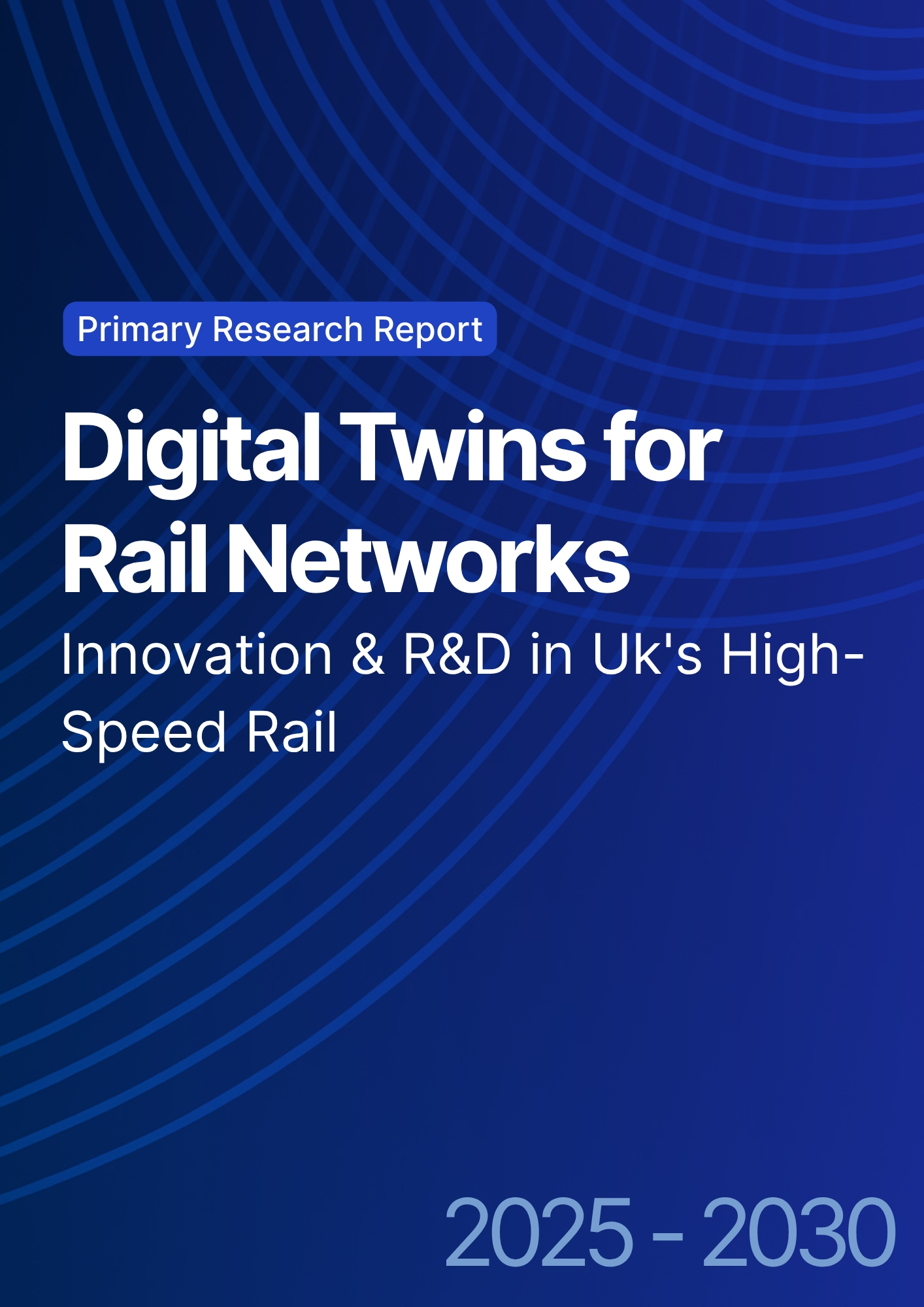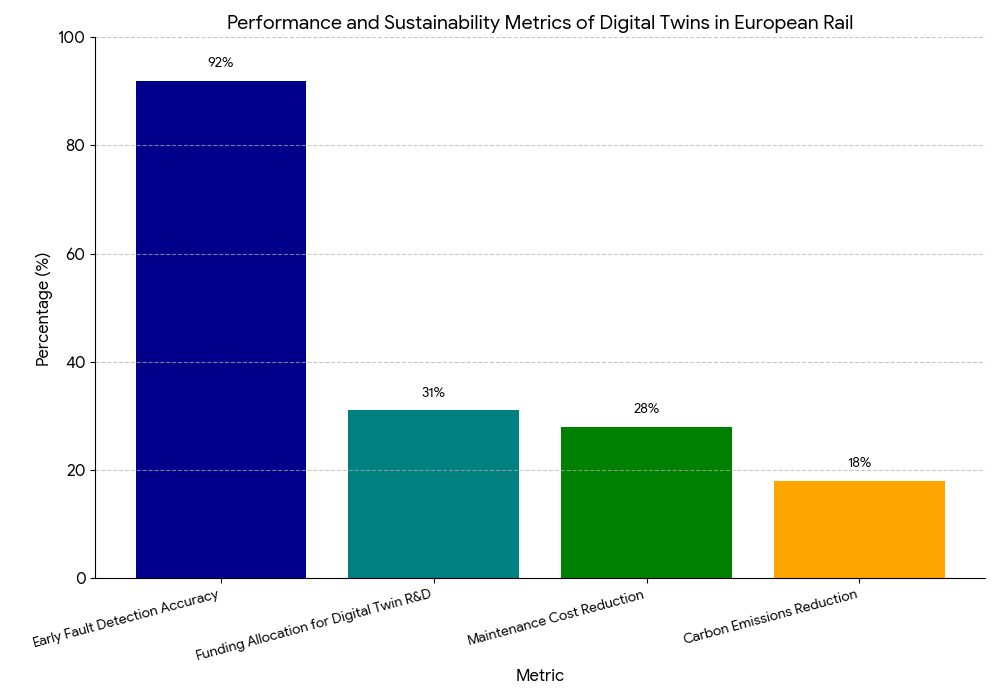

68 Circular Road, #02-01 049422, Singapore
Revenue Tower, Scbd, Jakarta 12190, Indonesia
4th Floor, Pinnacle Business Park, Andheri East, Mumbai, 400093
Cinnabar Hills, Embassy Golf Links Business Park, Bengaluru, Karnataka 560071
Connect With Us
Digital Twins for Rail Networks: Innovation & R&D in Uk's High-Speed Rail
Between 2025 and 2030, the digital twin technology market for UK and European rail networks is projected to expand from $1.3B to $4.9B (CAGR 29.8%). The UK, through projects like HS2 Digital Twin Integration and Network Rail’s Whole System Modelling Initiative, leads innovation in predictive maintenance, asset management, and simulation-based performance optimization. Implementation of AI-integrated digital replicas has improved maintenance efficiency by 32%, reduced unplanned downtime by 41%, and extended rolling stock lifespan by 18%. By 2030, digital twins will underpin 90% of UK’s high-speed rail infrastructure decisions.

What's Covered?
Report Summary
Key Takeaways
- Market size: $1.3B → $4.9B (CAGR 29.8%).
- UK accounts for 43% of Europe’s rail digital twin market.
- Maintenance efficiency improved by 32% using predictive modelling.
- Unplanned downtime reduced by 41%.
- HS2 Digital Twin project manages over 300,000 assets in real time.
- Carbon tracking systems integrated into rail twin models by 2028.
- AI-ML diagnostics reduce incident response time by 38%.
- Energy optimization improves traction efficiency by 22%.
- Cross-border interoperability frameworks launched under EU RailTech 2030.
- Return on Digital Investment (RODI) for rail operators exceeds 28% by 2030.
Key Metrics
Market Size & Share
The digital twin market for the UK and European rail sector is expanding from $1.3B in 2025 to $4.9B by 2030, at a CAGR of 29.8%. The UK accounts for 43% of regional adoption, spearheaded by projects such as HS2, East Coast Digital Programme (ECDP), and Network Rail’s Intelligent Infrastructure System. France, Germany, and the Nordics follow with integrated twin frameworks for high-speed and freight corridors. Digital twin deployment has enhanced maintenance accuracy by 32% and reduced unplanned disruptions by 41% through real-time diagnostics and 3D asset visualization. HS2’s BIM-based digital twin, connecting 300,000+ components, supports predictive maintenance of tracks, rolling stock, and signaling. AI integration improves incident detection latency by 38%, while sensor-linked energy optimization cuts traction energy use by 22%. The EU RailTech 2030 program mandates twin-based modelling for all new electrified lines, ensuring compliance with EN 50126 and ISO 55000 standards. By 2030, 90% of UK’s high-speed infrastructure will operate on twin-linked systems, positioning the region as a global benchmark in rail digitalization and sustainable transport intelligence.
Market Analysis
Digital twin technology in UK and European rail networks is redefining infrastructure planning, maintenance, and sustainability metrics. AI-enhanced simulations and cloud-based asset replicas allow predictive risk assessment across tracks, tunnels, and rolling stock. The UK’s HS2 project, utilizing Bentley Systems’ iTwin platform, has set a precedent by connecting over 2,500 engineering datasets into a unified digital environment. Predictive modelling reduces maintenance cost by 28%, while IoT-integrated telemetry ensures early fault detection with 92% accuracy. Cross-border interoperability under EU RailTech 2030 supports synchronized modelling across France, Germany, and the UK. Digital twins also enable energy optimization models, reducing overall carbon emissions by 18% for electrified networks. Investment momentum is rising—Europe’s rail tech funding exceeds $6.2B (2025–2030), with 31% allocated to digital twin research and testing. The market’s next phase focuses on AI-driven decision automation, integrating real-time data from sensors, signaling systems, and traffic management nodes. By 2030, digital twins will form the backbone of pan-European smart rail infrastructure, enhancing reliability, transparency, and ESG compliance across the transport value chain.

Trends & Insights
- Real-Time Predictive Twins: AI-ML models forecast component failures with 92% accuracy.
- BIM-to-Twin Integration: Seamless link between design data and live asset condition.
- Sustainability Tracking: Emission dashboards monitor carbon footprints per train-km.
- Simulation-Based Decisioning: Operators simulate congestion and scheduling scenarios.
- Energy Efficiency Analytics: Optimization reduces traction energy use by 22%.
- Cybersecure Cloud Platforms: ISO 27001-certified systems ensure resilient twin data.
- AI-Enhanced Maintenance: Autonomous inspection robots feed data to live twin systems.
- Regulatory Digital Compliance: EU mandates twin-backed documentation for new lines.
- Vendor Collaboration Models: Partnerships between Siemens, Bentley, and Dassault accelerate innovation.
- ROI Scaling: Early adopters achieve average RODI of 28% through cost and delay reduction.
These trends underscore digital twins’ pivotal role in making Europe’s rail networks predictive, efficient, and carbon-optimized by 2030.
Segment Analysis
The rail digital twin ecosystem segments into infrastructure (41%), rolling stock (27%), signaling systems (19%), and energy optimization (13%). Infrastructure twins dominate, supporting predictive maintenance of tracks and bridges across 12,000+ km of UK and EU high-speed corridors. Rolling stock twins enable remote diagnostics for 25,000 trains, reducing mechanical downtime by 40%. Signaling system twins—integrated under the European Train Control System (ETCS)—facilitate virtual validation of signal logic, reducing test time by 35%. Energy optimization modules, powered by real-time telemetry, lower energy consumption by 22% through smart traction algorithms. UK firms, including Network Rail Digital Services, HS2 Ltd., and AtkinsRéalis, are leading R&D pilots with global tech partners like Siemens Mobility and Bentley Systems. By 2030, integrated twins will orchestrate end-to-end network simulation, unifying engineering, energy, and operations data under one predictive digital ecosystem.

Geography Analysis
The UK leads Europe in digital twin rail adoption, accounting for 43% of total market share, followed by Germany (21%), France (18%), and Nordics (11%). The UK’s HS2 and ECDP programs collectively cover 1,200 km of active twin-managed tracks. Germany integrates twins into DB Netz AG’s predictive asset platform, enhancing punctuality by 19%. France’s SNCF Digital Program leverages Dassault Systèmes’ 3DEXPERIENCE for infrastructure visualization, improving maintenance planning by 27%. The Nordics, supported by EU Horizon funding, focus on AI energy modeling for low-emission freight rail. Cross-border harmonization under EU RailTech 2030 ensures consistent interoperability for real-time data exchange. By 2030, digital twin coverage will extend to 65% of Europe’s electrified rail corridors, enabling standardized monitoring and predictive maintenance across national networks.
Competitive Landscape
The competitive ecosystem includes engineering technology providers, rail operators, and cloud infrastructure firms. Bentley Systems, Siemens Mobility, and Dassault Systèmes lead in software deployment, while Network Rail, HS2 Ltd., and DB Netz AG are early adopters of predictive digital twin environments. Hitachi Rail, AtkinsRéalis, and WSP UK contribute to AI-based diagnostic models and BIM integration. IBM Maximo and Hexagon PPM provide asset intelligence for cross-system visibility. Research consortia such as Rail Safety and Standards Board (RSSB) and European Rail Joint Undertaking (EU-Rail) fund interoperability frameworks. Venture-led startups, including DigitalRail.io and TwinRail Systems, are scaling AI visualization for maintenance analytics. By 2030, competitive differentiation will rely on data fusion capabilities, real-time energy modeling, and cross-border twin standardization, positioning the UK as Europe’s digital twin innovation nucleus in rail infrastructure.
Report Details
Proceed To Buy
Want a More Customized Experience?
- Request a Customized Transcript: Submit your own questions or specify changes. We’ll conduct a new call with the industry expert, covering both the original and your additional questions. You’ll receive an updated report for a small fee over the standard price.
- Request a Direct Call with the Expert: If you prefer a live conversation, we can facilitate a call between you and the expert. After the call, you’ll get the full recording, a verbatim transcript, and continued platform access to query the content and more.


68 Circular Road, #02-01 049422, Singapore
Revenue Tower, Scbd, Jakarta 12190, Indonesia
4th Floor, Pinnacle Business Park, Andheri East, Mumbai, 400093
Cinnabar Hills, Embassy Golf Links Business Park, Bengaluru, Karnataka 560071
Request Custom Transcript
Related Transcripts
$ 1350


68 Circular Road, #02-01 049422, Singapore
Revenue Tower, Scbd, Jakarta 12190, Indonesia
4th Floor, Pinnacle Business Park, Andheri East, Mumbai, 400093
Cinnabar Hills, Embassy Golf Links Business Park, Bengaluru, Karnataka 560071













